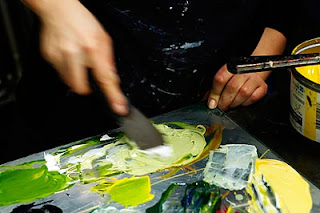 It is pretty well impossible to take a really good photograph that does not have something in focus. Something sharp to give meaning to the picture. I have suggested in the past that this could be just the visible grain in the picture but I could be clutching at straws with that idea, trying to justify some poor effort on my part... No, I really think that there needs to be something to grab the viewer's attention.
It is pretty well impossible to take a really good photograph that does not have something in focus. Something sharp to give meaning to the picture. I have suggested in the past that this could be just the visible grain in the picture but I could be clutching at straws with that idea, trying to justify some poor effort on my part... No, I really think that there needs to be something to grab the viewer's attention.However, the presence of something sharp in the picture does not make it a good picture, often the parts of the photograph that are out of focus do more to elevate the picture into something really nice.
Out of focus stuff is more likely to be important in terms of shape and colour, I could tell you that the yellow behind the poppy seed-head is a pair of marigolds (the flowers, not the rubber gloves) but it is irrelevant to the reading of the picture. In the picture of the roses it is obvious that the colour behind is more roses but it really helps to highlight the stems.

When you take a picture you need to think about the layers, the foreground, the focussed areas and the background: will the aperture you are using give you enough depth for the subject and at the same time allow you to soften the fore and background? If you are shooting with toy cameras you often don't have the luxury of choice but you can still be aware of what will happen and choose the angles to put interesting stuff in the out of focus areas.
 In my Pylon picture I would have liked to get the wires themselves slightly further out of focus but here the softness gives height to the pylon where sharp wires would have created confusion - did I get away with it? Just, I think.
In my Pylon picture I would have liked to get the wires themselves slightly further out of focus but here the softness gives height to the pylon where sharp wires would have created confusion - did I get away with it? Just, I think.This is one of the most fundamental skills to learn as a photographer, knowing - preferably instinctively - how much to get sharp and always looking at what is going on in the background so that you can accommodate it into your picture - or avoid it.
Photography, for me, is exciting because of the things you can do with it that are not normally visible, and the juxtaposition of sharp and blurred is among the most thrilling.

This final picture is not one of mine, it couldn't be since it was shot in the very early '60's, around when I was born. It is a portrait of actress Jean Marsh taken by my father Brian Shuel. I knew as soon as I decided the subject for this blog that this picture should be included to illustrate what I mean. If the tree were either sharp or not there the picture would be the poorer for it. I really love this picture and I'm grateful to my dad for letting me use it.
When you are taking pictures look at everything, and let you mind focus as well as your camera, not only on the subject but also on the picture that the subject will become...







 All of this can be learned from digital equipment, none of it is the exclusive domain of film, but I promote playing with film and 'toy cameras' because they force you to learn whilst most digital cameras allow you not to have to learn.
All of this can be learned from digital equipment, none of it is the exclusive domain of film, but I promote playing with film and 'toy cameras' because they force you to learn whilst most digital cameras allow you not to have to learn. 





 As a further development of some of the ideas I have blogged about over the past few months I wanted to play a little more with close-up photography with a Holga. I have been enjoying the Holga 135BC (Black Corner) camera that I have - and which you could have too for just £40 from
As a further development of some of the ideas I have blogged about over the past few months I wanted to play a little more with close-up photography with a Holga. I have been enjoying the Holga 135BC (Black Corner) camera that I have - and which you could have too for just £40 from 


